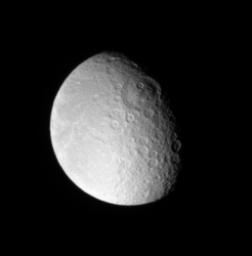
|
Tirawa on the Terminator
- Click the image above for a larger view
- Full-Res JPEG (246 x 250) (3.9 kB)
- Full-Res TIFF (246 x 250) (61.8 kB)
Caption:
Rhea sports an immense impact scar on its leading hemisphere, like several other major Saturnian moons. The impact basin, seen above center on the day-night dividing line, or terminator, is named Tirawa, and is about 360 kilometers (220 miles) across.
North on Rhea (1,528 kilometers, or 949 miles across) is up.
The image was taken in visible light with the Cassini spacecraft narrow-angle camera on June 1, 2007. The view was acquired at a distance of approximately 1.6 million kilometers (1 million miles) from Rhea and at a Sun-Rhea-spacecraft, or phase, angle of 55 degrees. Image scale is 10 kilometers (6 miles) per pixel.
Background Info:
The Cassini-Huygens mission is a cooperative project of NASA, the European Space Agency and the Italian Space Agency. The Jet Propulsion Laboratory, a division of the California Institute of Technology in Pasadena, manages the mission for NASA's Science Mission Directorate, Washington, D.C. The Cassini orbiter and its two onboard cameras were designed, developed and assembled at JPL. The imaging operations center is based at the Space Science Institute in Boulder, Colo.
For more information about the Cassini-Huygens mission visit http://saturn.jpl.nasa.gov/home/index.cfm . The Cassini imaging team homepage is at http://ciclops.org .
Cataloging Keywords:
| Name | Value | Additional Values |
|---|---|---|
| Target | Rhea | |
| System | Saturn | |
| Target Type | Satellite | |
| Mission | Cassini-Huygens | |
| Instrument Host | Cassini Orbiter | |
| Host Type | Orbiter | |
| Instrument | Imaging Science Subsystem (ISS) | |
| Detector | Narrow Angle Camera | |
| Extra Keywords | Grayscale, Impact, Visual | |
| Acquisition Date | ||
| Release Date | 2007-07-04 | |
| Date in Caption | 2007-06-01 | |
| Image Credit | NASA/JPL/Space Science Institute | |
| Source | photojournal.jpl.nasa.gov/catalog/PIA08976 | |
| Identifier | PIA08976 | |
